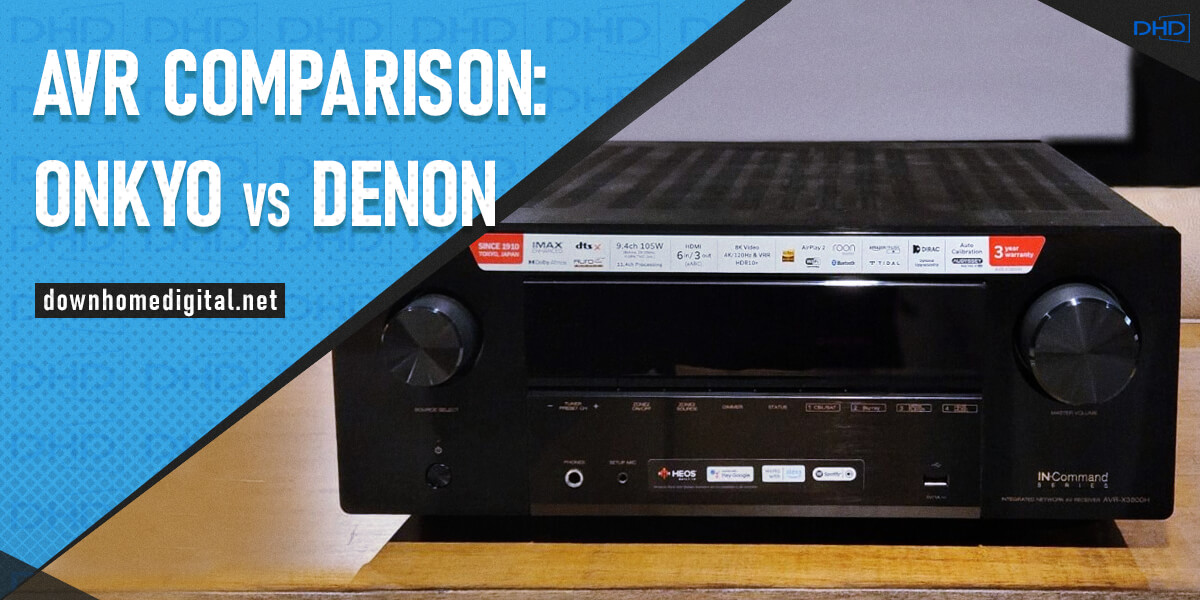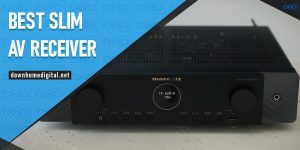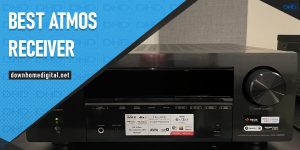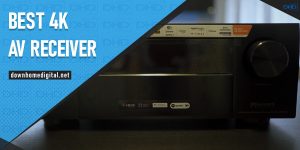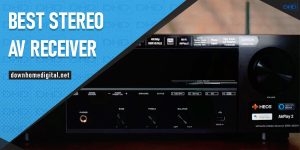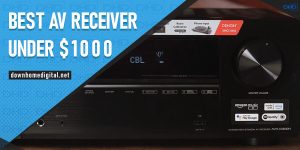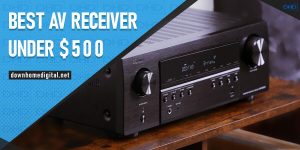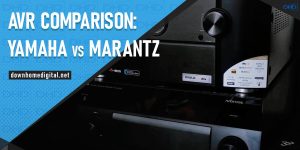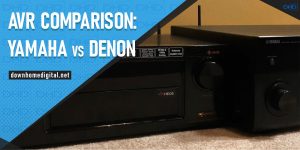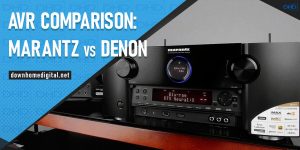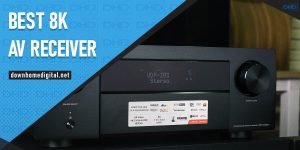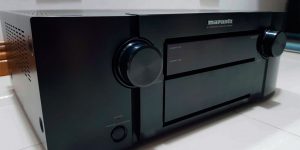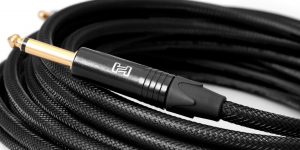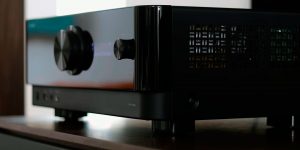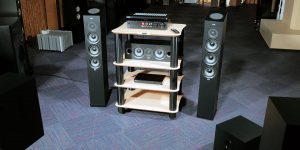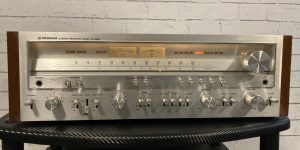In this article, I want to bring you another “battle of the brands.” This time, it is Denon vs. Onkyo. I will compare the most interesting receivers of these two brands. As usual, I have chosen models from different price segments in order to cover the possible range. This comparison aims to find out which model is better in its category and to make it easier for you to choose between Denon and Onkyo.
Denon company history and overview
In 1910, Frederick Whitney Horn, a native of the United States, founded the Nipon Chikuonki Shokai Company. It specialized in the production of phonographs and records of classical music. In 1927, part of its shares was acquired by Columbia Graphophone Company, and in January 1928, the Nippon Columbia Phonograph Company Ltd was formed.
The modern brand name (Denon) appeared only in 1939, when the name of one of the subsidiaries, Japan Denki Onkyo, was combined into one word. So it is essentially an acronym.
Gradually, Nippon Columbia expanded its areas of activity, increasing the range of products. Since 1971, the company has been producing and selling Hi-Fi components: amplifiers, tuners, and vinyl record players. Then, in 1981, the company released the world’s first CD player – DN-3000FE, and a year later, DCD-2000 came, designed for home CD playback.
In 2001, the company was reorganized into a corporation with 98% ownership by Ripplewood Holdings and 2% by Hitachi Corporation. In 2002, Denon merged with the Japanese company Marantz.
Today Denon is one of the market leaders in various audio equipment: receivers, speakers, vinyl players, headphones, etc. As history has shown, Denon’s mission has always been to create products that combine the highest standards of sound quality and reliability. The company aimed to convey the passion and energy depicted in music and movies, as well as the emotions and vision of musicians and filmmakers. Denon engineers constantly innovate to change the present and believe that new technologies and breakthroughs lie ahead.
Onkyo company history and overview
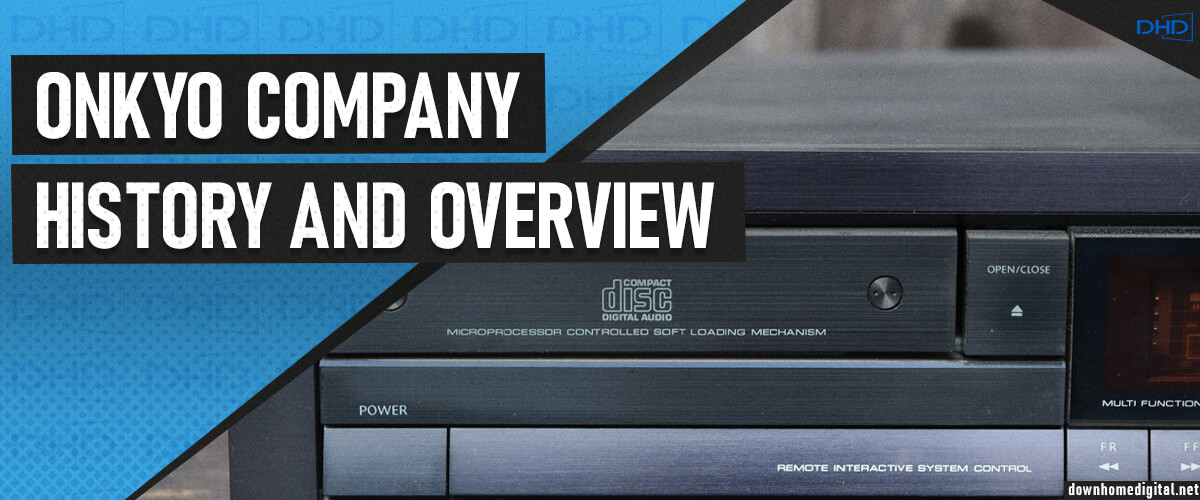
To correctly compare Onkyo receivers with competitors from the Denon camp, you need to know the history of this brand. The Japanese company Onkyo was founded in 1946 and was initially called Osaka Denki Onkyo K.K. After almost 100 years, it is a reputable manufacturer of audio and video systems for home consumption.
The first Onkyo receivers hit the market in the 1970s and were immediately recognized and loved by consumers. In 2000, the company created the first multi-channel receiver, and in 2001, the receiver was first connected to a home theater system by the company’s technicians. In 2002, Onkyo already added an Ethernet interface to its receivers, allowing you to connect them to computers.
Today, Onkyo receivers are targeted at the general consumer and compete with other market leaders. Through continuous development and experimentation with sound, the company has achieved quite a high level and recognition among many users worldwide.
How I tested receivers by Denon and Onkyo
I performed Denon vs. Onkyo sound quality testing in two aspects: music performance and movie sound. I chose Blade Runner 2049 (one of my favorite movies) and used the following songs to test the musical capabilities:
- Max Roach – Lonesome Lover – SoundCloud
- Anne Sofie von Otter – Baby Plays Around – Deezer
- The Chemical Brothers – Das Spiegel – Spotify
- The Weeknd – The Hills (CD player)
- Led Zeppelin – Ramble On (CD player)
- George Gershwin – Rhapsody in Blue (CD player)
- Thundercat – Uh Uh (CD player)
- Daft Punk – Get Lucky (CD player)
In addition to the receivers, the following equipment was used:
- CD player SACD 30n
- Blu-ray player Sony UBP-X700
- Speaker wire – AudioQuest Type-9
- Speakers for movie – Klipsch RP-8060FA
- Stereo speakers:
- Klipsch RP-8060FA
- KEF Q350
- DALI OBERON 5
Mid-price Denon and Onkyo receivers comparison
Denon AVR-X3800H vs Onkyo TX-RZ50
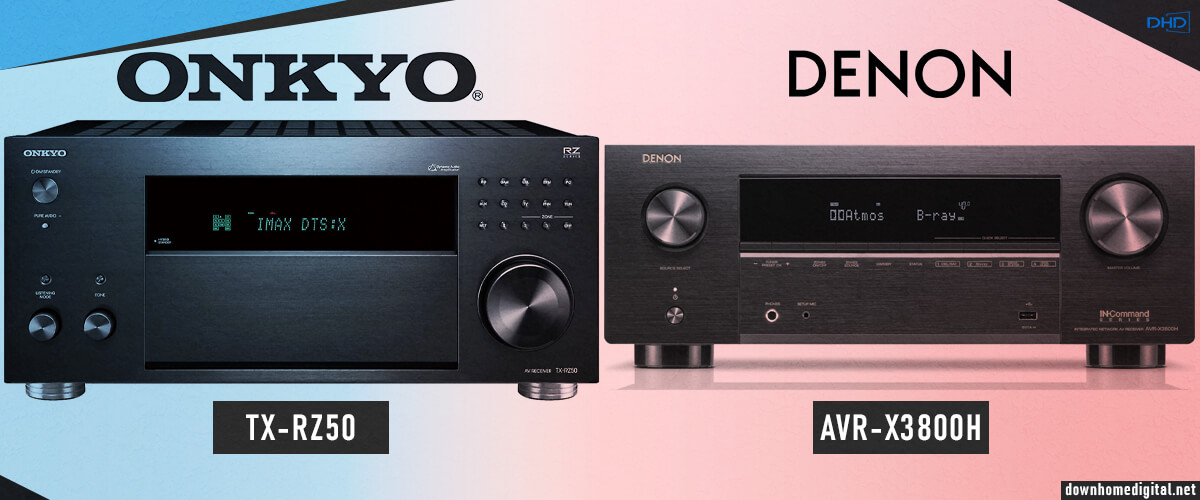
I will start with the most popular segment of receivers – Mid-price. I’ve chosen 2 models, with a good set of features and I’m sure you’ll be interested to know which is better, Denon or Onkyo?
The Denon AVR-X3800H is the 2020 model with a winning combination of features, performance, and price. It has many advantages inherent in even higher-end receivers, so the Onkyo TX-RZ50 has a worthy contender.
Let’s start with appearance and construction. Weight matters because it speaks to the quality of the components inside. Both models have an impressive weight of 30.9 (Onkyo) and 27.6 (Denon) pounds, so they have good ventilation, and the internal components don’t create electronic interference that can translate into noise. The design is simple and classic. But the Onkyo has a button panel on the side of the LCD and under a removable cover, and it is a set of round buttons that aren’t very comfortable to press. I wish I could say that the Denon has more comfortable controls, but no. I got my fingers all over the LCD while pressing the narrow buttons just below it. Otherwise, it feels old school: the controls are smooth and reliable, the cabinet is sturdy, and the LCD is bright and informative.
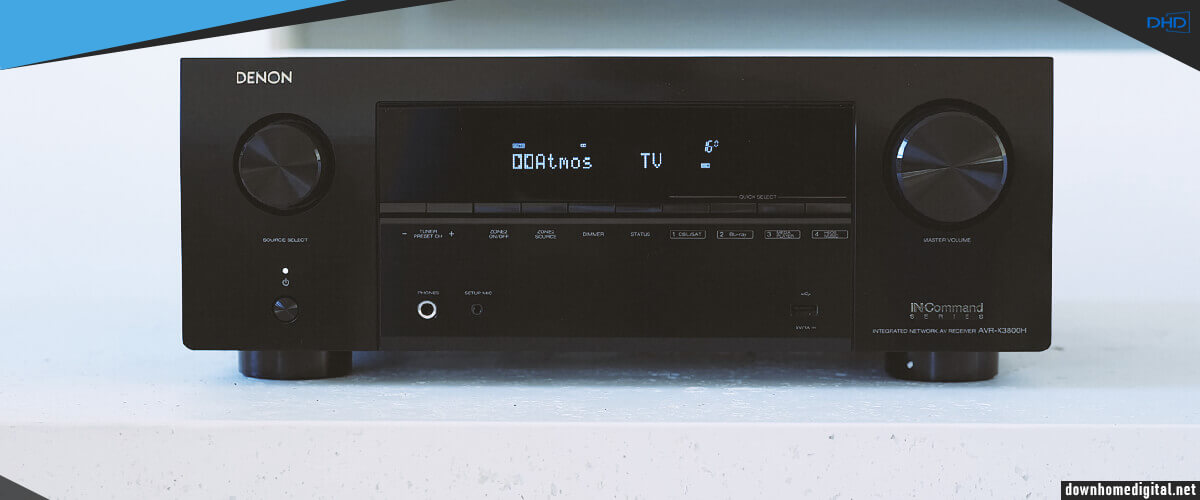
Although the X3800H has nine built-in channels, you can customize it however you like, from a standard 5.1-channel configuration to an exciting 7.4.4 configuration with four independent subwoofers (but it will require additional amplification). Its power handling capacity is 105 W (8 ohm, 20 Hz – 20 kHz, 0.08%, 2ch). The TX-RZ50 is an incredibly powerful 9.2-channel receiver that delivers 140 W (8 ohms, 20 Hz – 20kHz, 0.08%, 2 ch) and can also be expanded to 11 channels. But you can only connect two subs to it. As you can see, Denon is thoughtfully inferior to Onkyo, but due to the comprehensive bass support in practice, you won’t notice the difference in power (of course, when fully equipped with 4 bass drivers).
The X3800H has 6/3 HDMI ports, each capable of handling 4K/60Hz, HDR10, HLG, HDR10+, and Dolby Vision. All of them support the latest HDMI 2.1 specifications, such as 8K/60Hz, 4K / 120Hz, VRR, ALLM, and eARC. Wi-Fi, AirPlay 2, Bluetooth, and the HEOS multi-room system are also present. It adds a wireless rear speaker and subwoofer capability and makes the Denon AVR-X3800H work with Amazon Alexa, Google Assistant, and Apple’s Siri. As for Onkyo, it has pretty much the same connectivity and connectivity options (7/2 HDMI), except for a few important points. This model has Bluetooth bi-directional technology, which not only allows you to stream music from your gadget but also allows you to transmit audio played via AVR to compatible wireless headphones. Unlike the Denon HEOS, it has full Zone 2 support. In addition, the TX-RZ50 can work with three Sonos ports – one for each of the three independent zones – each playing a completely different streaming service from Sonos Radio. Thus, despite almost equal capabilities, a slight advantage regarding connection methods still remains with Onkyo.
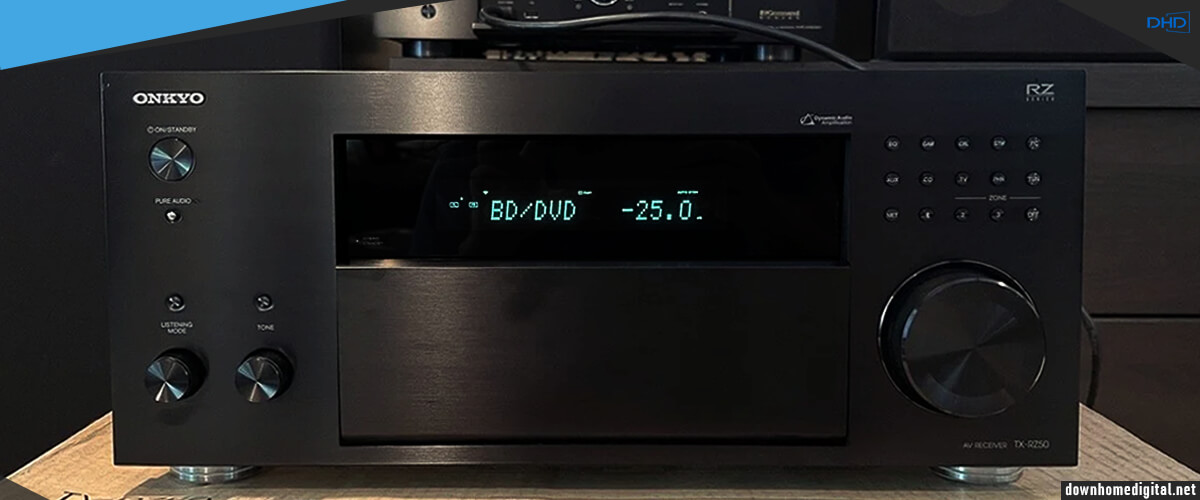
The Denon AVR-X3800H can decode major object-oriented audio formats such as Dolby Atmos, DTS: X, and IMAX Enhanced. Having tested the audio, I will note that I liked its quality. It had great cinematic delivery and accurate audio placement across the room. Regardless of what’s happening on the screen, the dialogue always remains clear and focused on the action. Thanks to Audyssey room correction, the subwoofers integrate perfectly with the other speakers in the system, blending seamlessly and producing deep yet controlled bass. In addition, Denon’s two-channel playback ability amazed me with the clean reproduction and even distribution of the music across the front soundstage. The most striking difference from its opponent is its support for the immersive, popular Auro 3D format.
The Onkyo TX-RZ50, like its competitor, supports modern surround sound formats (except Auro 3D). Still, it is also certified to offer four different THX listening modes: movies, games, music, and surround sound EX. Incidentally, in 1993, Onkyo became the first home theater electronics brand to achieve THX certification. As far as sound was concerned, it was terrific.
And a couple of other interesting points. The TX-RZ50 features Klipsch Optimize Mode, which allows you to integrate the Klipsch Reference and Reference Premiere speakers with your receiver. You can now select which speaker models you will use for each individual channel, and optimized crossover settings will automatically be applied.
With identical video tract data and wireless capabilities (both support 8K video and a myriad of streaming services and voice assistants), the featured models have some advantages over each other. The Onkyo TX-RZ50 is more powerful, and you won’t need the extra woofers and THX Certification. The Denon AVR-X3800H supports Auro 3D and has a native multi-room HEOS system (for the Onkyo, you must buy a separate Sonos system). Onkyo has a worse room correction system than Denon’s Audyssey, but both models support the currently unrivaled Dirac Live.
These are two bright representatives of the mid-price segment, equipped with many useful features, but, most importantly, really guaranteeing excellent sound quality. For me, the clear favorite will always be Denon, as I am a longtime fan of the brand for its brightness and dynamics, clear sound in every scene, and both in surround sound and stereo. But I’m not at liberty to diminish Onkyo’s merits in the case of the TX-RZ50. It’s an excellent mid-range model that’s worth every penny. The final decision is up to you, and whatever choice you make, you’re sure to be satisfied with it!
| Key specs | Denon AVR-X3800H | Onkyo TX-RZ50 |
| Channels | 9.4 | 9.2 |
| Power output | 105 W/8 Ohm, 135 W/6 Ohm | 120 W/8 Ohm, 250 W/6 Ohm |
| HDMI inputs/outputs | 6/3 (8K/60Hz and 4K/120Hz pass-through) | 7/2 (8K/60Hz and 4K/120Hz pass-through) |
| Bluetooth/Wi-Fi | yes/yes | yes/yes |
| Video functions | HDMI to HDMI scaling (up to 8K 60/50) | HDMI to HDMI scaling (up to 8K 60/50) |
| Supports | HDMI ARC, HDMI eARC, HDMI CEC, HDCP2.3, HDR10, HDR10+, Dolby Vision | HDMI ARC, HDMI CEC, HDCP2.3, HDR10, HDR10+, Dolby Vision |
| Streaming services | AirPlay2, Spotify, Pandora, Tidal | AirPlay2, Spotify, Pandora, Tidal |
| Surround sound | DTS:X, Dolby Atmos | DTS:X, Dolby Atmos, IMAX Enhanced |
Denon AVR-X3800H pros and cons
Pros
- Deep and powerful sound.
- Heos app to control the various connected devices.
- Auro 3D support.
Cons
- Has fewer HDMI input ports than the competitor.
Onkyo TX-RZ840 pros and cons
Pros
- Incredibly powerful model.
- THX certification.
- Works with Sonos.
- Klipsch Optimize Mode.
Cons
- No Auro 3D support.
Premium Denon and Onkyo receivers comparison
Onkyo TX-RZ3100 vs Denon AVR-X6700H
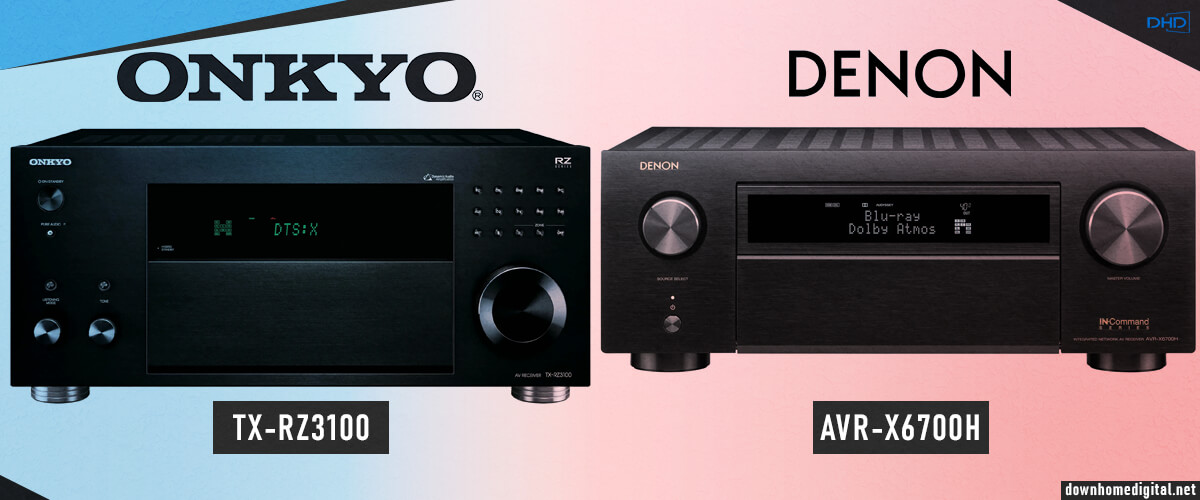
It’s time to compare premium AV receivers. Both Onkyo TX-RZ3100 and Denon AVR-X6700H work with 11.2 channels. But – to the broads! The model from Denon handles 13 channels with the addition of an external amplifier. The power of the receivers is identical and is 140 W (8 Ohm, 20 Hz – 20 kHz, 2 ch). At the same time, AVR-X6700H has better THD (0.05% vs. 0.08%). But here’s a surprise – this device is out of production, so hurry up and buy it (it’s worth it). This is even though Denon released its premium AVR in 2020, while the Onkyo TX-RZ3100 has held its ground since 2016. Intrigued?
The exterior of the TX-RZ3100 is no different from the previously described Onkyo TX-RZ50. Only its weight is, even more, 43 pounds (still, there are 11 amplifiers here). The AVR-X6700H externally also resembles other brand models, but this time, it also has a removable cover under which the control is hidden. If it weren’t for the small buttons on Onkyo’s body (which I think will get clogged with dust over time), I’d say the receivers being compared are virtually identical. There’s no reason to repeat myself; everything works at a high class, as it should in the premium segment. But I didn’t like the remote control in either one or the other. Rather simplistic, not too helpful. But Denon has a special app, and it is extremely useful here.

The video capabilities are again radically different, in favor of the Denon AVR-X6700H. This receiver supports a video stream with a resolution of 8K/60 Hz (one HDMI). Along with this, there is an up-scaling up to 8K and a pass-through video stream. Alternatively, the Onkyo TX-RZ3100 can still run at a 4K resolution maximum. Moreover, I found here the up-scaling, but only up to 4K, and pass-through feature. However, I cannot but mention that Onkyo does not have HDR 10+ and Dynamic HDR support. And also, in a pair of these two receivers, only Denon has built-in eARC.
Testing has shown that receivers of such high quality do an excellent job of creating a cinema ambiance and correctly and accurately reproducing surround sound effects. The main advantage of the AVR-X6700H is that it has Auro 3D support. Plus, when using HDMI eARC, I heard details that are impossible to hear with the Onkyo TX-RZ3100. In its performance, the layering of sound effects usually looks flatter. In fact, that’s normal for it. Actually, that’s what makes it more affordable today.
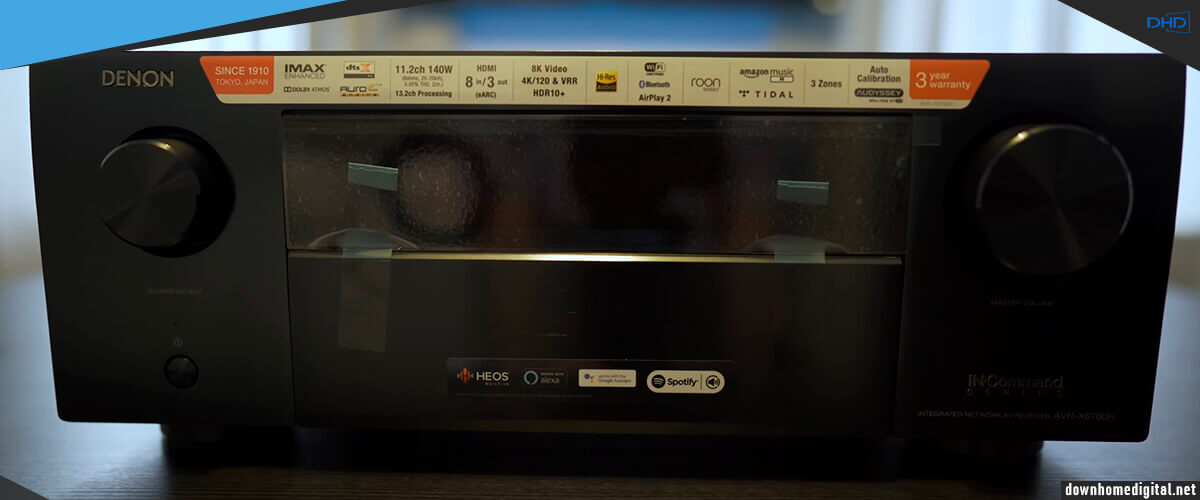
In the music test, the differences appeared. Again, this is influenced by brand orientation. The Denon`s receiver still suppresses detail with its unrestrained bass. Onkyo’s receiver, on the other hand, acts more like an amplifier than a receiver. That is, you can’t say it sounds bad, but it doesn’t add anything to enhance the music or make it brighter. At the same time, the AVR-X6700H makes you feel like you’re in the studio in front of artists who are recording an album.
So, what conclusion can be drawn from all of the above? First of all, both models are a bit behind the modern requirements. AVR-X6700H has only 1 HDMI port that supports 8K video and eARC. The Onkyo TX-RZ3100 only provides 4K resolution. In surround sound, the Denon also outperforms the Onkyo as it can decode Auro 3D and IMAX Enhanced. But all the fat is in what these once-premium models have under the hood.
The AVR-X6700H and TX-RZ3100 have 11 built-in amplifiers and 140 watts of power. Given the quality of surround and stereo sound effects reproduction, both receivers can be considered versatile for organizing a large system with multiple service areas. Denon has gone further, and you can add a third-party amplifier, thus expanding the system to 13 channels.
Therefore, if you are not too frozen on modern chips but want an extensive home theater, you have every chance to buy one. Denon AVR-X6700H is obviously more advanced, but the Onkyo TX-RZ3100 is cheaper (within the middle segment). A unique choice, a worthy one.
| Key specs | Denon AVR-X6700H | Onkyo TX-RZ3100 |
| Channels | 11.2 | 11.2 |
| Power output | 140 W/8 Ohm, 175 W/6 Ohm | 140 W/8 Ohm, 200 W/6 Ohm |
| HDMI inputs/outputs | 8/3 (8K/60Hz and 4K/120Hz pass-through) | 8/2 (4K/60Hz pass-through) |
| Bluetooth/Wi-Fi | yes/yes | yes/yes |
| Video functions | video conversion analog to HDMI, HDMI to HDMI scaling (up to 8K 60/50) | video conversion analog to HDMI, HDMI to HDMI scaling (up to 4K/60) |
| Supports | HDMI ARC, HDMI eARC, HDMI CEC, HDCP2.3, HDR10, HDR10+, Dolby Vision | HDMI ARC, HDMI CEC, HDCP2.2, HDR10, Dolby Vision |
| Streaming services | AirPlay2, Spotify, Pandora, Tidal | AirPlay, Spotify, Pandora, Tidal |
| Surround sound | DTS:X, Dolby Atmos | DTS:X, Dolby Atmos |
Denon AVR-X6700H pros and cons
Pros
- Expandable up to 13 channels (with separate amplifier).
- THD is better (0.05 vs. 0.08%).
- Supports 8K video.
- Supports Auro 3D.
Cons
- Only 1 port has version 2.1 (obsolescence).
- Discontinued.
Onkyo TX-RZ3100 pros and cons
Pros
- Priced within the mid-range segment today.
- THX Certification.
Cons
- Does not support 8K resolution.
- Does not support eARC.
- Does not support Auro 3D.
Budget Denon and Onkyo receivers comparison
Onkyo TX-SR393 vs Denon AVR-S570BT

When comparing Onkyo vs Denon, I don’t forget the entry-level models. Both of these devices operate in 5.2 channel mode. And looking at audio processing, it became clear to me the key differences between these models. The first is the power of the amplifier. Onkyo TX-SR393 operates at 80 W/8 Ohm or 155 W/6 Ohm. On the other hand, Denon AVR-S570BT is inferior to the competitor and has 70 W/8 Ohm or 90 W/6 Ohm. However, not only in this, but the Denon`s receiver also loses. While the TX-SR393 supports Dolby Atmos and DTS: X decoders (which is unusual for 5-channels AVR), the Denon AVR-S570BT lacks them.
Budget models are characterized by lightweight, rather fragile housings that squeeze under your fingers. TX-SR393 and AVR-S540BT are not too soft, but the difference with more expensive models is obvious even by touch. I liked Onkyo’s controls better; the buttons are big and comfortable to press. But this is not as important as the fact that both models have treble and bass adjusted by buttons. That is, you can’t adjust the nuances the way you want. You choose from the options offered. This is a frequent phenomenon with cheap receivers.
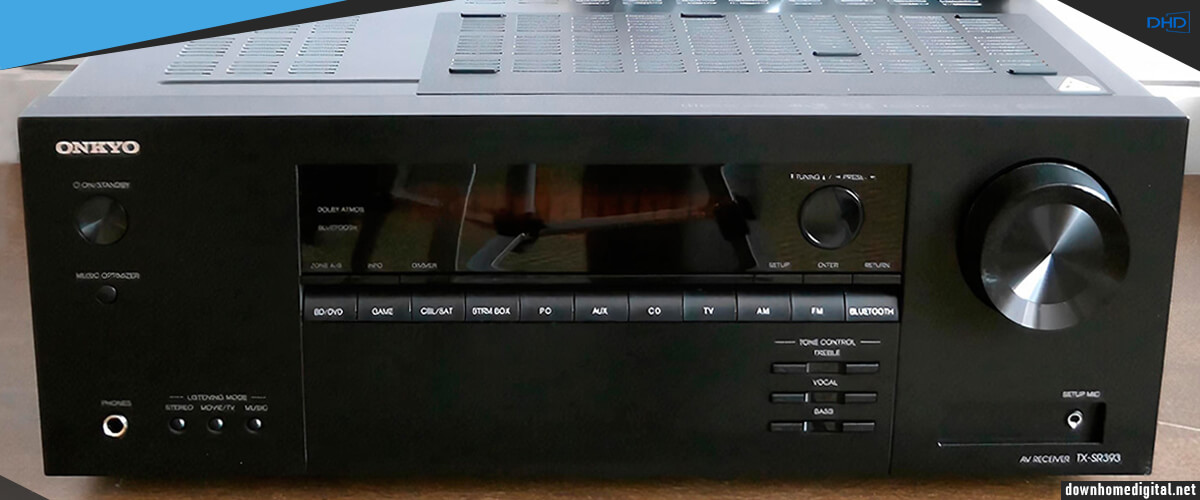
A brief word about networking features. Neither Onkyo TX-SR393 nor AVR-S540BT has any networking features at all except Bluetooth. But in both cases, they support AAC codec, which means high compatibility with Apple devices. I liked the signal strength of both of them, the fast connection, and the clear playback without sagging.
The AVR-S570BT’s video path is better, as all its ports support 8K (the TX-SR393 only has 4K). This is a tribute to the year of production. At the time of Onkyo’s release (2019), version HDMI 2.1. had not yet been implemented, and the 2022 Denon was one of the first budget receivers with this data. Another advantage is the full functionality for gamers.
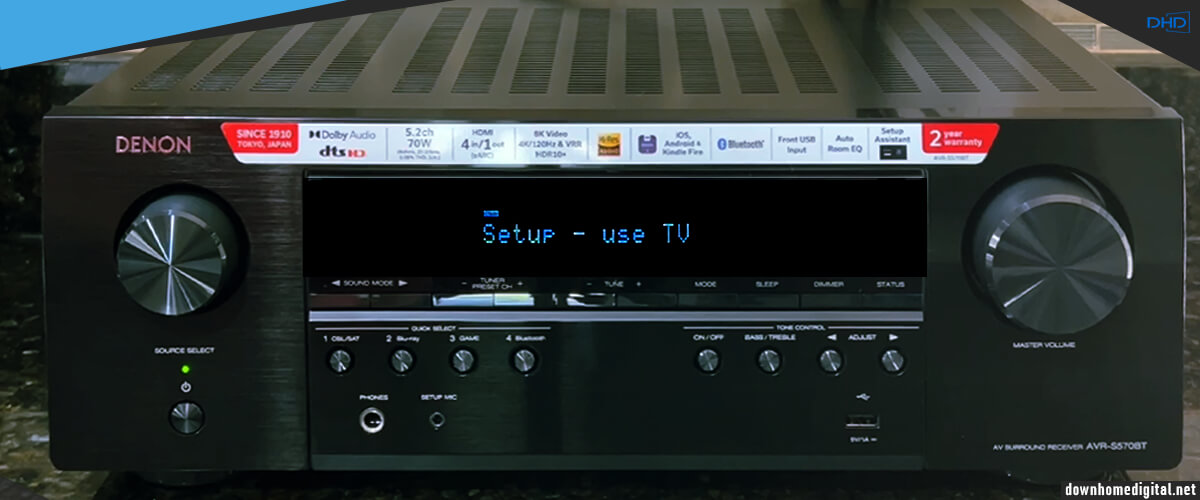
The TX-SR393 performed much better than the competitor when watching the movie, thanks to its surround decoders. Sound effects moved around the soundstage and positioned according to what was happening on the screen. I can’t say that the sound dynamics were exciting, but the quality was enough to make the movie enjoyable. The Denon AVR-S570BT did not respond well to the film. The situation was saved by the presence of the DTS HD Master, which allowed me to hear the multi-channel sound, but without sound objects. The musical component of the receivers is slightly better. Each of the models produced a fairly balanced sound with good detail.
In this case, the deciding factor will be the budget and the desire to have Dolby Atmos and DTS:X surround sound formats or the best video path (8K, including gamer capabilities). In the first case, choose Onkyo TX-SR393 (cheaper); in the second case, choose Denon AVR-S570BT.
Both models provide a decent level of sound, and to be honest, in the 3.2.2 configuration (Onkyo’s), Dolby Atmos doesn’t sound like it does, even with a 7-channel receiver. But because of the availability of decoding for more complex surround sound formats, you get the AccuEQ automatic calibration system. At the same time, the AVR-S570BT only has a calibration microphone. Either way, remember that the models are very basic. Neither has Wi-Fi (only Bluetooth, but not bad). All in all, if you don’t set too many expectations, you will get pleasure.
| Key specs | Denon AVR-S570BT | Onkyo TX-SR393 |
| Channels | 5.2 | 5.2 |
| Power output | 70 W/8 Ohm, 90 W/6 Ohm | 80 W/8 Ohm, 155 W/6 Ohm |
| HDMI inputs/outputs | 4/1 (4K/60Hz pass-through) | 4/1 (4K/60Hz pass-through) |
| Bluetooth/Wi-Fi | yes/no | yes/no |
| Video functions | 4K/60Hz pass-through | 4K/60Hz pass-through, HDMI to HDMI scaling (up to 4K/60) |
| Supports | HDMI ARC, HDMI CEC, HDCP2.2, HDR10, Dolby Vision | HDMI ARC, HDMI CEC, HDCP2.2, HDR10, Dolby Vision |
| Streaming services | no | no |
| Surround sound | DTS HD Master, Dolby TrueHD | DTS:X, Dolby Atmos |
Onkyo TX-SR393 pros and cons
Pros
- Supports Dolby Atmos and DTS: X surround sound decoders.
- Has AccuEQ automatic calibration system.
Cons
- Supports 4K video only.
- No Wi-Fi.
Denon AVR-S570BT pros and cons
Pros
- Performs end-to-end transmission of 8K video.
- Has features for gamers.
Cons
- No Wi-Fi.
- Calibration with microphone.
Stereo Denon and Onkyo Receivers Comparison
Denon DRA-800H vs Onkyo TX-8260
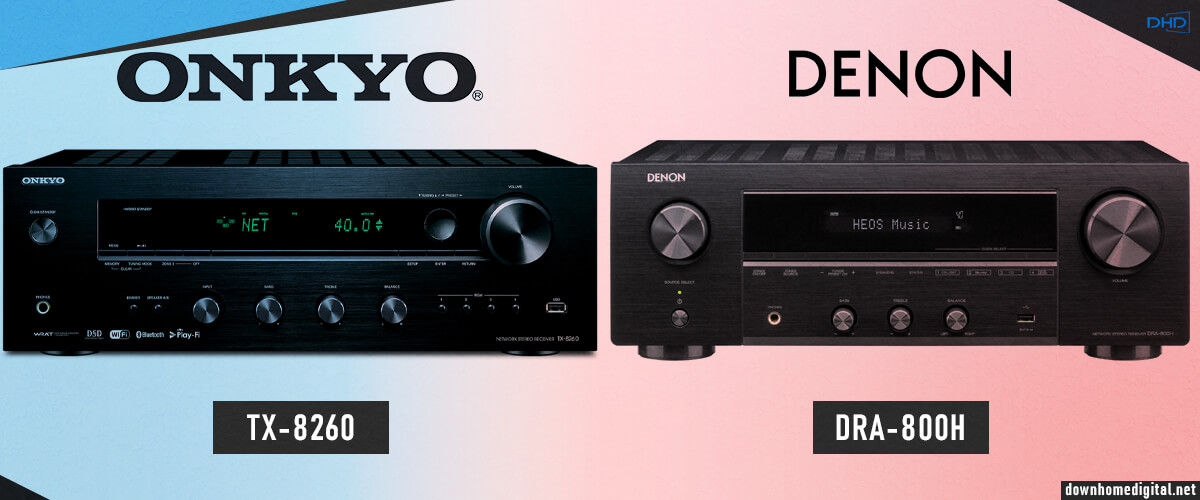
Concluding the series of comparisons, I looked at the Denon DRA-800H vs Onkyo TX-8260. But only one of them combines a stereo amplifier unit and a video path for a 4K video playback. The DRA-800H features 5/1 HDMI version 2.0 connectors with ARC, CEC, HDCP 2.3, and ALLM (Auto Low Latency Mode) Pass-through for gaming, making it a hybrid device for mini home theater integration.
Despite the low cost (the models have been out for quite a while, Denon in 2019 and Onkyo in 2017), I mainly liked the frequency tuning with the round controls. The Denon is still better, smoother, and more precise in finding the right level. This time, the TX-8260 is very similar to the DRA-800H’s design, repeating the push-button control right under the LCD. It’s not overly convenient but standard on most classic design models. What’s also important compared to other brands, both models can connect to two sets of speakers and with Gold Plated Screws. Most stereo receivers of this rank have spring-loaded terminals. In my opinion, the professional approach of the manufacturers is quite visible here. The only too important disadvantage of the Onkyo TX-8260 is the fixed power cable. This option makes it difficult to replace the cable in case of breakage.
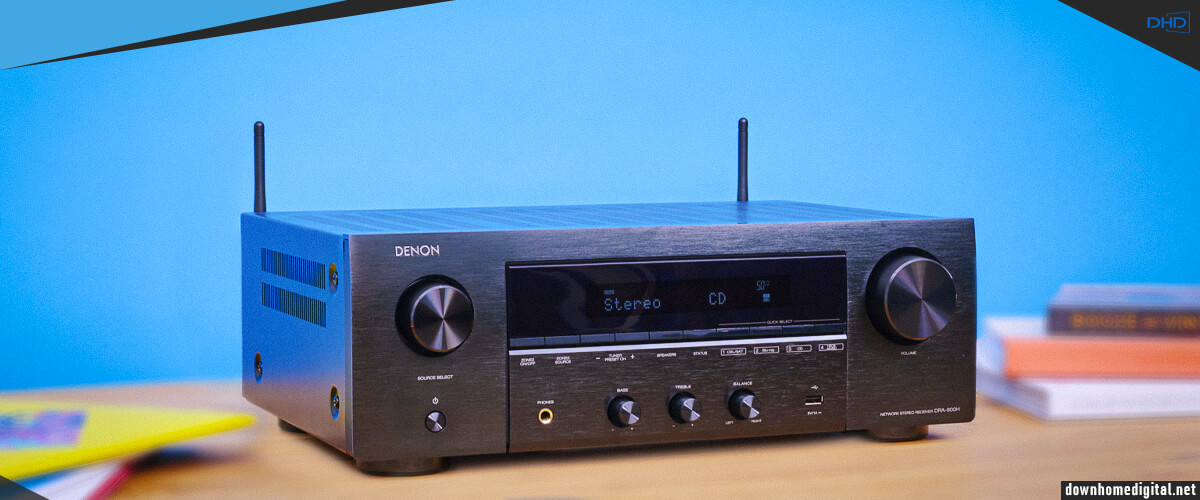
The most exciting part of each receiver is the amplifier. The Denon DRA-800H can operate in two-channel mode with support for two subwoofer outputs but without bi-amplification. In this mode, the receiver can deliver 100 W/8 Ohm or 120 W/6 Ohm. Such power allows the receiver to handle playback of high-quality audio and even vinyl (thanks to Phono in).
The competitor, the Onkyo TX-8260, is built with discrete amplifiers and produces 80 W/8 Ohm or 160 W/6 Ohm per channel. Also, I want to mention that this receiver circuit has Asahi Kasei AK4452VN DAC, which allows the receiver to handle any Hi-Res files. In addition, this audio circuit design allows the receiver to operate two sets of speakers, which cannot be done with the DRA-800H.
Both receivers have advanced network functions. The manufacturers have implemented support for music streaming services such as Spotify, Pandora, etc. Wi-Fi and Ethernet modules are responsible for connecting to the network. And for communication with other devices, there is Bluetooth and AirPlay2. However, I want to say that TX-8260 still stands out from the competition because of the built-in Chromecast and FireConnect.
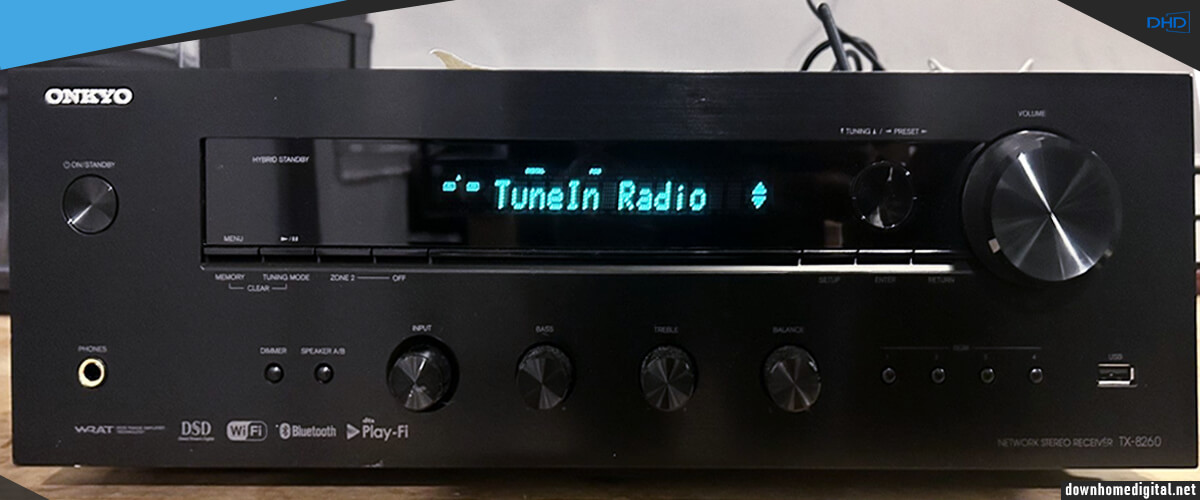
Now I want to move on to the testing of devices. I will immediately note that the model DRA-800H was pleasantly surprised and pleased with the purity, transparency, and enviable detail of the sound picture. The device reproduced high-frequency and mid-frequency components of the sound range very accurately and sounded quite dense and confident in the low frequencies.
The Onkyo TX-8260 also managed to please me. The sound stage was with characteristic dynamics, the bass range never seemed strained, always matched the timing, and the other frequency ranges also had a clear and distinct structure. However, compared to the Denon, which is better, this stereo receiver lacked transparency and power in the lower frequency range.
Both receivers will do a good job reproducing any audio source in a typical high-end fashion. But the Onkyo TX-8260 has an advanced Asahi Kasei AK4452VN DAC, and there’s a clear advantage on the instruments. You probably won’t hear the difference unless you have absolute hearing. However, the Denon DRA-800H offers more transparency and power in the lower frequency range.
If you’ve been looking for a stereo receiver solely for music, the Onkyo TX-8260 will satisfy you completely. But it has a fixed power cable, making it difficult to fix if it breaks. Denon DRA-800H will suit those who want to get 4K video (it has 5/1 HDMI ports) in addition to stereo sound.
These aging models are still relevant and are bright examples that reliable things do not go out of fashion. You can connect two sets of speakers to each of them, all using Gold Plated Screws. And that’s a sign of long-lasting quality sound, too. Go for it!
| Key specs | Denon DRA-800H | Onkyo TX-8260 |
| Channels | 2.0 | 2.0 |
| Power output | 100 W/8 Ohm, 120 W/6 Ohm | 80 W/8 Ohm, 160 W/6 Ohm |
| HDMI inputs/outputs | 5/1 | 0/0 |
| Phono Input | yes | yes |
| Bluetooth/Wi-Fi | yes/yes | yes/yes |
| Streaming services | AirPlay2, Spotify, Pandora | AirPlay, Spotify, Pandora |
Denon DRA-800H pros and cons
Pros
- 5/1 HDMI ports with 4K video support.
- Gold Plated Screws for audio connection.
Cons
- No Bi-amplification function.
Onkyo TX-8260 pros and cons
Pros
- The Asahi Kasei AK4452VN DAC allows the receiver to handle any Hi-Res files.
- The built-in Chromecast and FireConnect.
Cons
- Fixed power cable.
Discontinued models
Denon AVR-X2700H vs Onkyo TX-NR797
Time marches on, and newer, modern ones are replacing good models. This section presents a couple I think are still relevant and may be interesting as their price has been reduced.
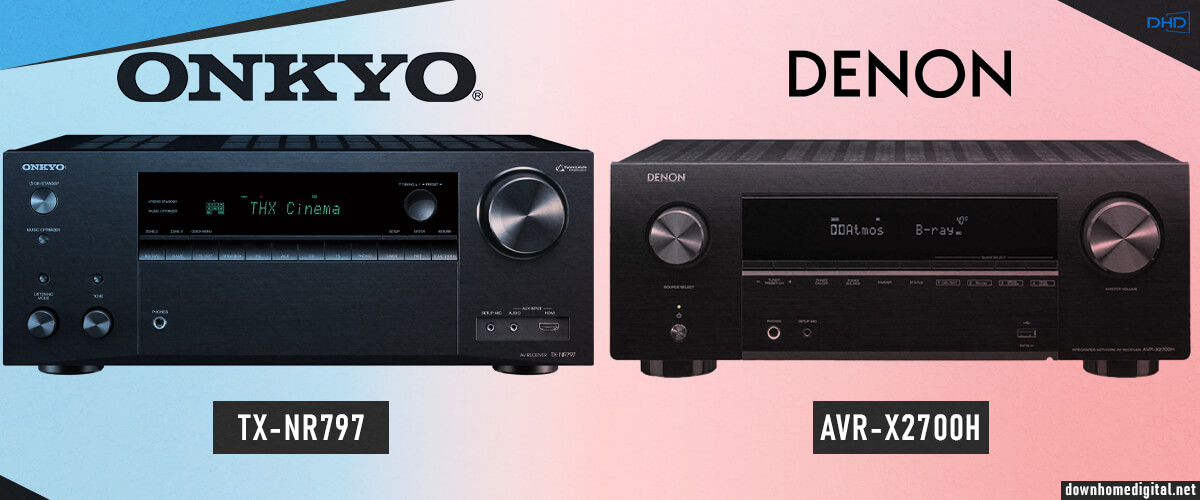
Here, I offer you a comparison of two radically different models. I start with one clear difference between Onkyo versus Denon. The Denon AVR-X2700H is a 7.2 channel receiver, while the Onkyo TX-NR797 can handle 9.2 channels. In addition, there are differences in power per channel: the AVR-X2700H delivers 95 W / 8 Ohm, 125 W / 6 Ohm, compared to 100 W/8 Ohm for the TX-NR797. However, regarding the supported audio features, there are no differences. It has a standard set of technologies from Dolby and DTS and the lack of Auro 3D.
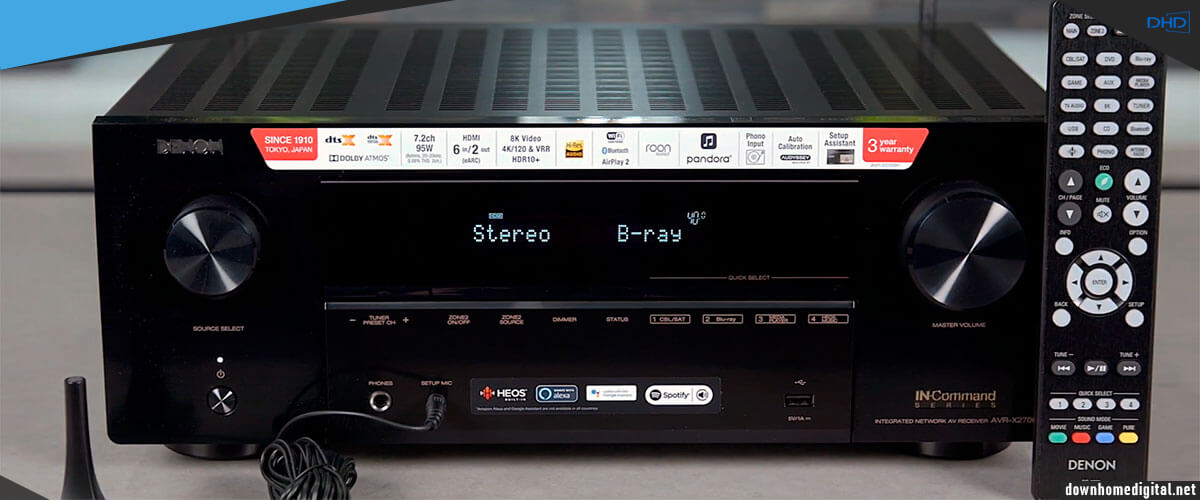
When we talk about video processing, I can’t say there are many similarities. The AVR-X2700H is the 8K-ready receiver. It has HDCP 2.3 and 8K signal pass-through. Moreover, only in Denon, I found the video up-scaling feature up to 8K/60 Hz. On the other hand, the TX-NR797 supports only 4K/60 Hz processing without an up-scaling feature. However, I should note that there are 4K pass-through and Analog to HDMI video conversion.
The listening test I began from the movie. As I expected, the Denon produced a deep and dynamic sound with strong bass. The sound was powerful, but sometimes I lacked the details. In turn, the Onkyo receiver floods the room with soft and detailed sound. All the effects are in their places, but the former dynamics are lacking.
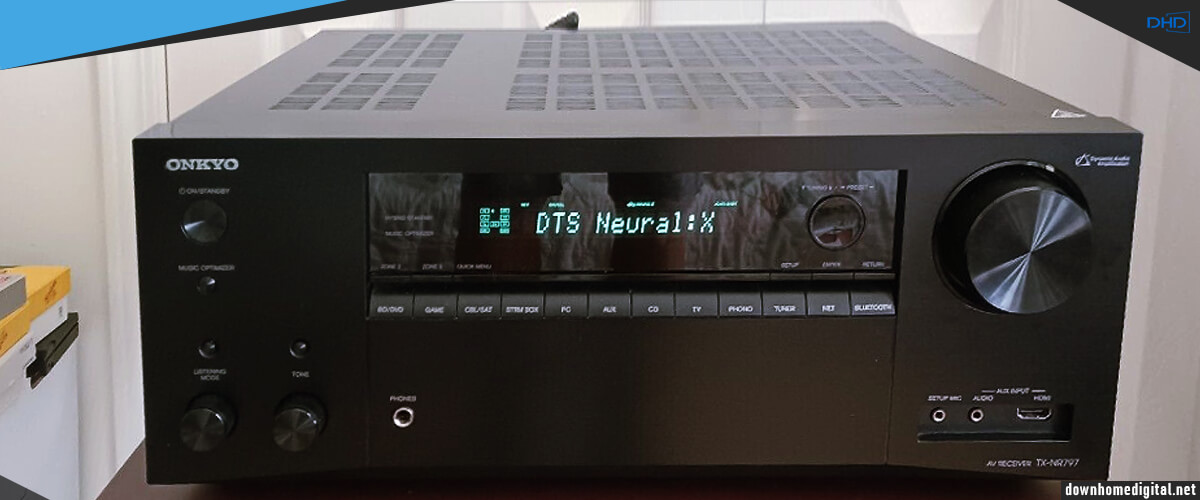
In music testing, I preferred the TX-NR797 sound. The sound is smooth and soft, where all registers are clearly defined. I heard the details of vocals and instruments perfectly. However, the AVR-X2700H`s sound is entirely different. The receiver performs in the same manner, as in the test with the movie – powerfully and dynamically, but details are partially lost.
Having listened to both receivers, I can confidently claim that the Onkyo TX-NR797 is a better choice for listening to music because of its not very dynamic sound and the great sound performance. Alternatively, the Denon AVR-X2700H will be good for a home cinema setup. It has enough dynamics, but not enough detail for working with music.
| Key specs | Denon AVR-X3700H | Onkyo TX-RZ840 |
| Channels | 9.2 | 9.2 |
| Power output | 95 W/8 Ohm, 125 W/6 Ohm | 100 W/8 Ohm |
| HDMI inputs/outputs | 6/2 (8K/60Hz and 4K/120Hz pass-through) | 7/2 (4K/60Hz pass-through) |
| Bluetooth/Wi-Fi | yes/yes | yes/yes |
| Video functions | HDMI to HDMI scaling (up to 8K 60/50) | video conversion analog to HDMI |
| Supports | HDMI ARC, HDMI eARC, HDMI CEC, HDCP2.3, HDR10, HDR10+, Dolby Vision | HDMI ARC, HDMI CEC, HDCP2.3, HDR10, Dolby Vision |
| Streaming services | AirPlay2, Spotify, Pandora, Tidal | AirPlay2, Spotify, Pandora, Tidal |
| Surround sound | DTS:X, Dolby Atmos | DTS:X, Dolby Atmos |
Onkyo TX-NR797 pros and cons
Pros
- Soft and detailed sound.
- There is an Analog to HDMI video conversion function.
Cons
- The lack of Auro 3D.
Denon AVR-X2700H pros and cons
Pros
- Excellent producing of surround sound effects.
- Powerful amplifier unit.
Cons
- Sound details are lost in a powerful bass.

